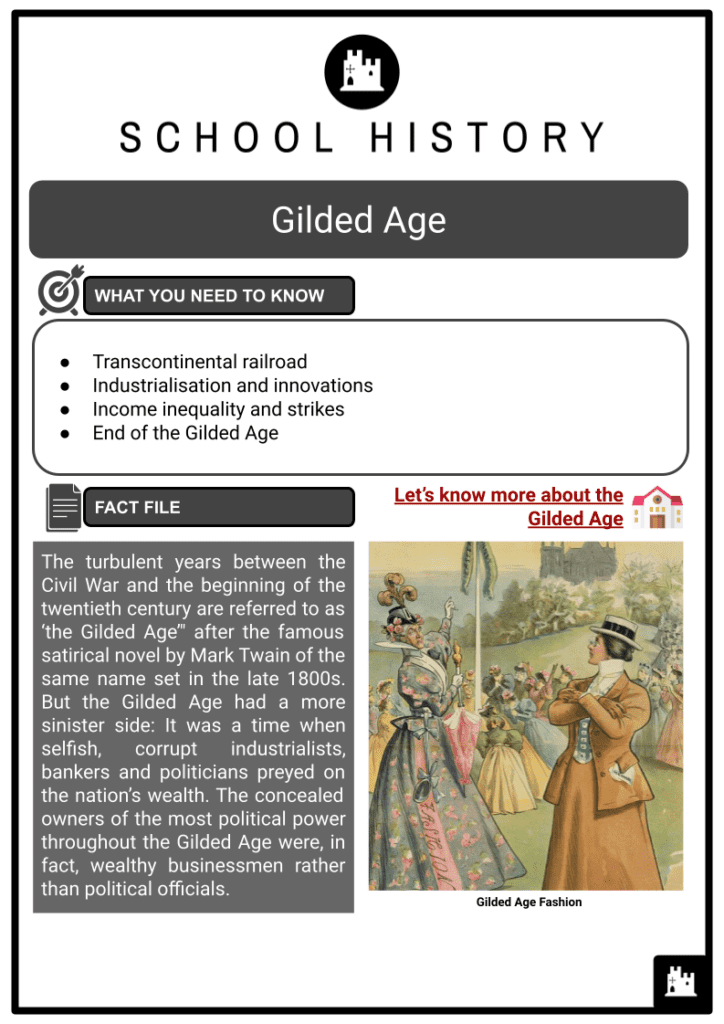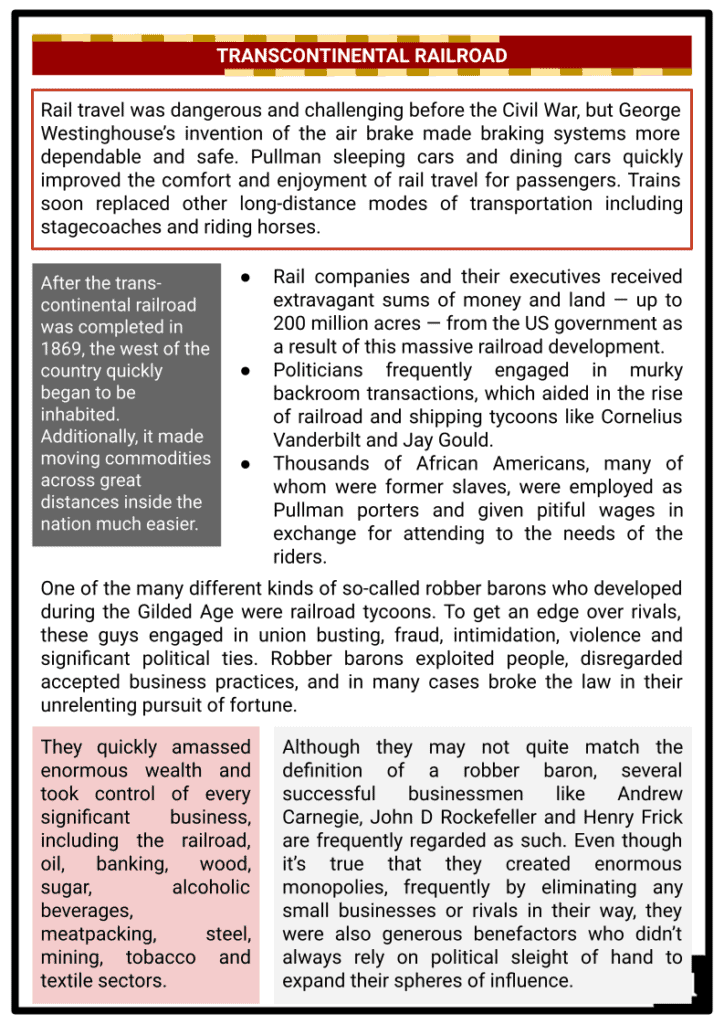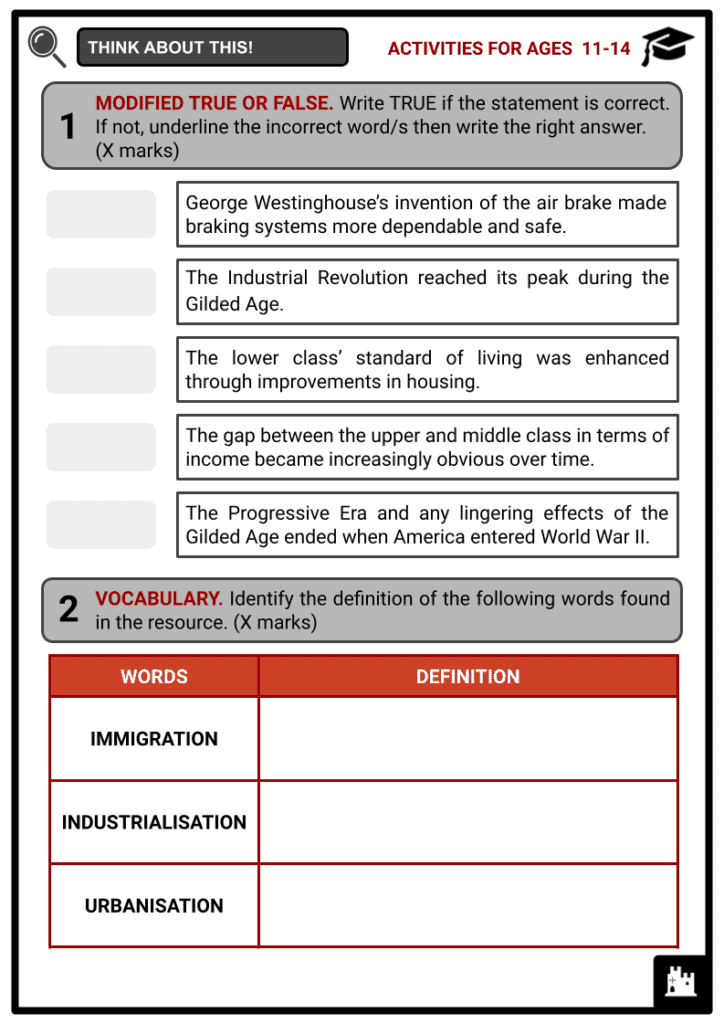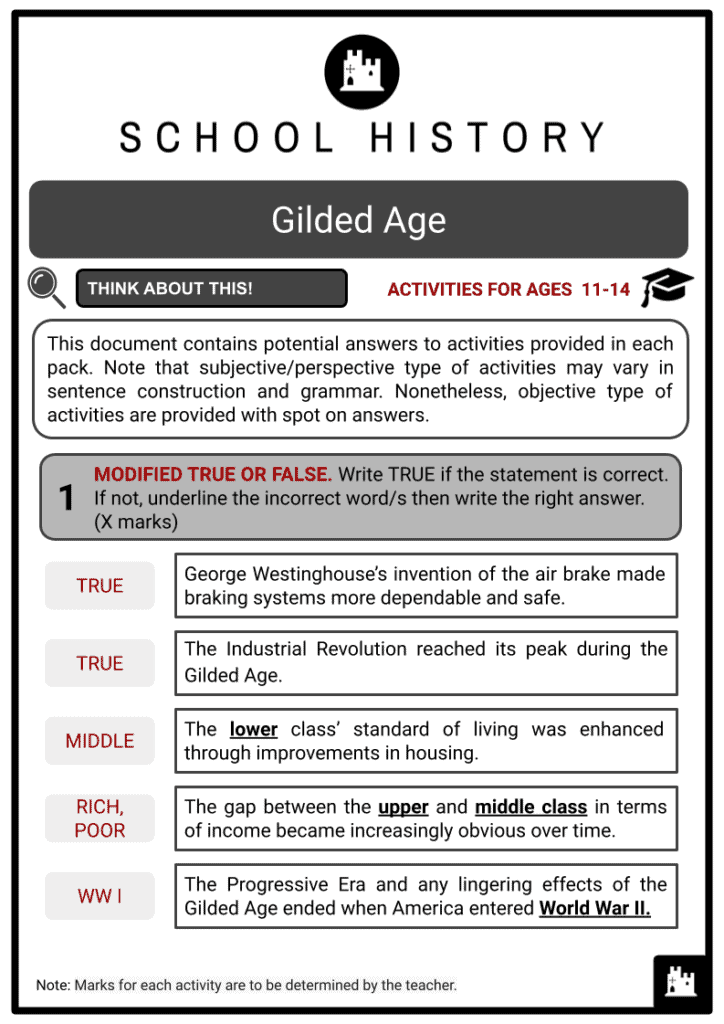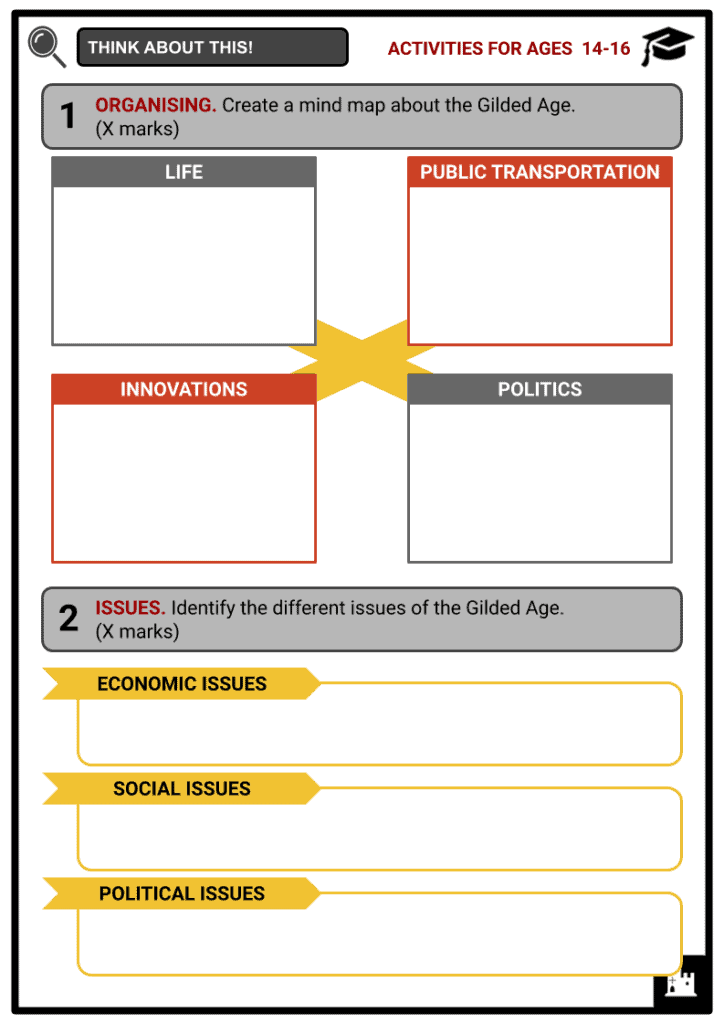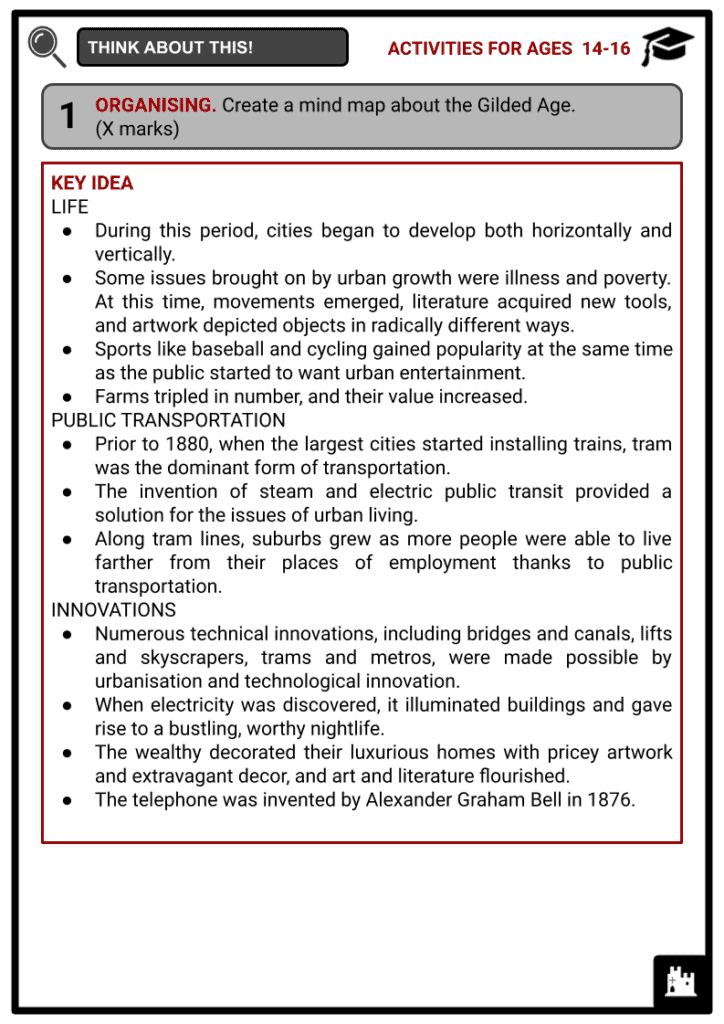Gilded Age Worksheets
Do you want to save dozens of hours in time? Get your evenings and weekends back? Be able to teach about the Gilded Age to your students?
Our worksheet bundle includes a fact file and printable worksheets and student activities. Perfect for both the classroom and homeschooling!
Summary
- Transcontinental railroad
- Industrialisation and innovations
- Income inequality and strikes
- End of the Gilded Age
Key Facts And Information
Let’s find out more about the Gilded Age!
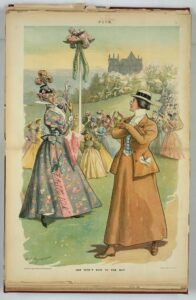
The turbulent years between the Civil War and the beginning of the twentieth century are referred to as ‘the Gilded Age’" after the famous satirical novel by Mark Twain of the same name set in the late 1800s. But the Gilded Age had a more sinister side: It was a time when selfish, corrupt industrialists, bankers and politicians preyed on the nation’s wealth. The concealed owners of the most political power throughout the Gilded Age were, in fact, wealthy businessmen rather than political officials.
TRANSCONTINENTAL RAILROAD
- Rail travel was dangerous and challenging before the Civil War, but George Westinghouse’s invention of the air brake made braking systems more dependable and safe. Pullman sleeping cars and dining cars quickly improved the comfort and enjoyment of rail travel for passengers. Trains soon replaced other long-distance modes of transportation including stagecoaches and riding horses.
- After the trans- continental railroad was completed in 1869, the west of the country quickly began to be inhabited. Additionally, it made moving commodities across great distances inside the nation much easier.
- Rail companies and their executives received extravagant sums of money and land — up to 200 million acres — from the US government as a result of this massive railroad development.
- Politicians frequently engaged in murky backroom transactions, which aided in the rise of railroad and shipping tycoons like Cornelius Vanderbilt and Jay Gould.
- Thousands of African Americans, many of whom were former slaves, were employed as Pullman porters and given pitiful wages in exchange for attending to the needs of the riders.
- One of the many different kinds of so-called robber barons who developed during the Gilded Age were railroad tycoons. To get an edge over rivals, these guys engaged in union busting, fraud, intimidation, violence and significant political ties. Robber barons exploited people, disregarded accepted business practices, and in many cases broke the law in their unrelenting pursuit of fortune.
- They quickly amassed enormous wealth and took control of every significant business, including the railroad, oil, banking, wood, sugar, alcoholic beverages, meatpacking, steel, mining, tobacco and textile sectors.
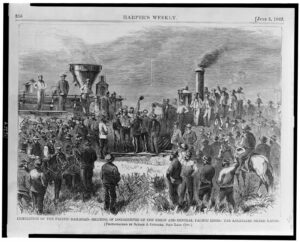
Transcontinental Railroad - Although they may not quite match the definition of a robber baron, several successful businessmen like Andrew Carnegie, John D Rockefeller and Henry Frick are frequently regarded as such. Even though it’s true that they created enormous monopolies, frequently by eliminating any small businesses or rivals in their way, they were also generous benefactors who didn’t always rely on political sleight of hand to expand their spheres of influence.
- Some attempted to improve the quality of life for their employees, gave millions to charities and organisations, and supported their communities by sponsoring institutions like zoos, hospitals, libraries and public parks.
INDUSTRIALISATION AND INNOVATIONS
- The Industrial Revolution, which saw America and much of Europe transition from an agricultural to an industrial civilisation, reached its peak during the Gilded Age. In search of employment and hastening the urbanisation of America, millions of immigrants and struggling farmers descended upon cities like New York, Boston, Philadelphia, St Louis and Chicago. About 40% of Americans were residing in big cities by 1900.
- Despite the fact that there were millions of industrial employees, the wealthy business owners who controlled the companies only made up a small portion of the population. During this period, the few rich people in the United States held the majority of the country’s wealth.The economic gaps between labourers and wealthy company owners widened dramatically throughout the Gilded Age. To survive, workers had to put up with poor pay and hazardous working conditions. However, big business owners lived luxurious lives.
- The luxurious homes of the Gilded Age elite were out of this world. The wealthy saw themselves as America’s royalty and would accept nothing less than estates deserving of that title.
- The Biltmore Estate in North Carolina, owned by George and Edith Vanderbilt, is one of the most well-known homes in America and was constructed during the Gilded Age.
- Prior to the couple’s marriage, construction on the 250-room chateau began in 1889 and lasted for six years. The estate had 35 bedrooms, 43 bathrooms, 65 fireplaces, a dairy, a horse stable, and spectacular formal and informal gardens.

Biltmore Estate - The Gilded Age’s innovations resulted in modern America. Numerous technical innovations, including bridges and canals, lifts and skyscrapers, tram lines and metros, were made possible by urbanisation and technological innovation. When electricity was discovered, it illuminated buildings and gave rise to a bustling, worthy nightlife. The wealthy decorated their luxurious homes with pricey artwork and extravagant decor, and art and literature flourished.
- The telephone was invented by Alexander Graham Bell in 1876, and it significantly reduced travel distances for both consumers and companies. The middle class’s standard of living was enhanced through improvements in housing, sanitation, and the availability of better food and material goods.
- However, while the middle and higher classes benefited from city living, nothing changed for the poor. Inhumane living conditions, high crime rates, and a miserable existence continued to be prevalent. Many people found solace in vaudeville shows or spectator sports like boxing, baseball or football, all of which saw a boom during the Gilded Age.
INCOME INEQUALITY AND STRIKES
- While the majority of the working class was subsistence-level, the industrialists of the Gilded Age lived large. The gap between rich and poor in terms of income became increasingly obvious over time. The poor were crammed into filthy tenement apartments, struggled to put a loaf of bread on the table, and frequently accompanied their children to a sweatshop each morning where they faced a 12-hour (or longer) workday. The wealthy lived in opulent homes, dined on delectable food, and showered their children with gifts.
- Most cities weren’t ready for the sudden increase in population. Due to the shortage of housing, tenements and slums sprang up everywhere.
- Millions of people perished from avoidable diseases because there was poor or no heating, lighting, sanitation, or medical treatment.
- Unskilled immigrants were prevalent and willing to put in long hours for low compensation.
- Gilded Age elites viewed them as the ideal workforce for their risky sweatshops, where workers experienced extended periods of unemployment, salary cutbacks, and a lack of benefits.
- Child labour was another problem that had an effect on the work force. Children performed duties that were occasionally quite dangerous in industries.
- Children, some as young as eight years old, skipped school in favour of working. They frequently had to perform the same tasks as adults for less money.
- Moreover, immigrants frequently settled in places that already had residents of the same race or ethnicity. As a result, ethnic neighbourhoods were built. These ethnic communities may be found in places like Chicago, Pittsburgh or New York City. Not everybody was in favour of immigrants coming to America. Numerous nativists believed that the immigration wave threatened American society. Since the 1840s, nativists have waged a crusade to defend native Americans’ rights in opposition to those of immigrants.
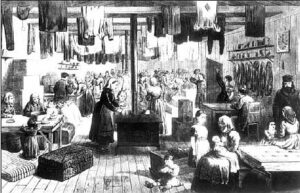
Quarters for new immigrants - Social Darwinism was cited by certain historians as a defence of class disparity. According to the belief, the most successful individuals are those who are physically fittest, while those who are poor are helpless because they are unfit and lack the necessary abilities to succeed.
- Reporters who revealed corruption among the elite and in politics are known as muckrakers. To reveal scandal and injustice, they dug through ‘the muck’ of the Gilded Age using investigative journalism and the print revolution. Upton Sinclair, a writer and activist journalist, published The Jungle in 1906 to expose the appalling working conditions in the meatpacking business. The Meat Inspection Act and the Pure Food and Drug Act were passed as a result of the book and the accompanying public outrage.
- It was soon clear that in order to improve their living and working conditions, the working class would need to band together because of the extreme wealth and poverty gap. It was also evident that some level of violence would be necessary for this to occur. However, much of the fighting occurred among the employees because they couldn’t agree on what they were fighting for. Some people only desired more pay and a better work environment, but others also wanted to exempt women, immigrants and people of colour from the labour force.
- The first labour unions were formed at the start of the nineteenth century, but the Gilded Age saw a surge in their popularity because of the rise of unskilled and dissatisfied manufacturing employees.
- A 10-percent wage decrease for railroad employees in Martinsburg, West Virginia, was announced by the Baltimore and Ohio Railroad Company on 16 July 1877. This was the second pay cut in less than eight months.
- With the help of the community, the employees declared they would block any trains from leaving the roundhouse until their salary was reinstated.
- The strike was unhindered by the mayor, the police, and even the National Guard. It wasn’t until federal forces came that one train eventually departed the station.
- The violence between the working class and local and federal authorities increased across America as the strike extended to other railways.
- Over 100,000 railroad workers were on strike at its height. The forceful, all-out movement against the robber barons’ manner of life terrified many of them.
- The strike, which eventually came to be known as the Great Upheaval, ended quickly and was thus deemed a miserable failure. However, it demonstrated to America’s business tycoons that there was power in numbers and that organised labour had the capacity to bring down large sectors of the economy and do significant political and economic harm.
- Bosses staged lock-outs and hired scab replacement workers while the working class persisted in using strikes and boycotts to demand greater wages and better working conditions. In order to stop active union workers from finding jobs elsewhere, they also developed blacklists. However, the working class persisted in uniting and fighting for their rights, frequently succeeding in at least part of their demands.
END OF THE GILDED AGE
- An unprecedented economic downturn in America began in 1893 as a result of the failure of the National Cordage Company and the overextended Philadelphia and Reading Railroad. Banks and other companies went out of business, the stock market crashed, and millions of people were left jobless, homeless and hungry. The unemployment rate reached over 50% in several states.
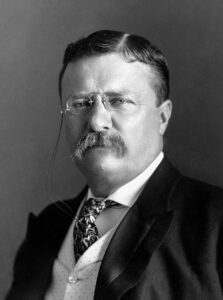
Theodore Roosevelt - Lower-class and even middle-class Americans became frustrated with governmental corruption and social injustice during the four-year long Panic of 1893. When President Theodore Roosevelt assumed office in 1901, the Progressive Movement was born out of their anger. Roosevelt believed in the need for federal restrictions to restrain excessive corporate greed and stop people from gaining outrageous sums of money off the backs of immigrants and the lower class, even if he favoured corporate America.
- The Progressive Era brought about a number of reforms that assisted in removing the robber barons from power, with the help of the muckrakers and the White House. These reforms included trust busting, labour reform, women’s suffrage, birth control, the establishment of trade unions, increased conservation efforts, food and medicine regulations, tax reform, civil rights, election reform, and fair labour standards.
- By 1916, many Americans had access to better housing, working conditions and pay, as well as cleaner and healthier towns, safer workplaces and less corrupt administrations. More people could follow the American Dream and launch their own enterprises if there were fewer monopolies. The Progressive Era and any lingering effects of the Gilded Age were practically over when America entered World War I in 1917 as the nation’s attention turned to the realities of war. However, the majority of robber barons and their families stayed affluent for many decades.
- However, many left charitable organisations and historical societies large portions of their fortune, property and mansions. Progressives kept up their efforts to support the weak and disenfranchised while bridging the wealth and poverty gap.
Image Sources
- https://cdn4.picryl.com/photo/1896/01/01/she-wont-bow-to-the-hat-cj-taylor-1024.jpg
- https://cdn18.picryl.com/photo/2019/10/07/completion-of-the-pacific-railroad-meeting-of-locomotives-of-the-union-and-8b697e-1600.jpg
- https://upload.wikimedia.org/wikipedia/commons/c/cd/Biltmore_Estate%2C_Asheville%2C_North_Carolina.jpg
- https://upload.wikimedia.org/wikipedia/commons/2/26/Volga-Germans-US.jpg
- https://en.wikipedia.org/wiki/Theodore_Roosevelt

